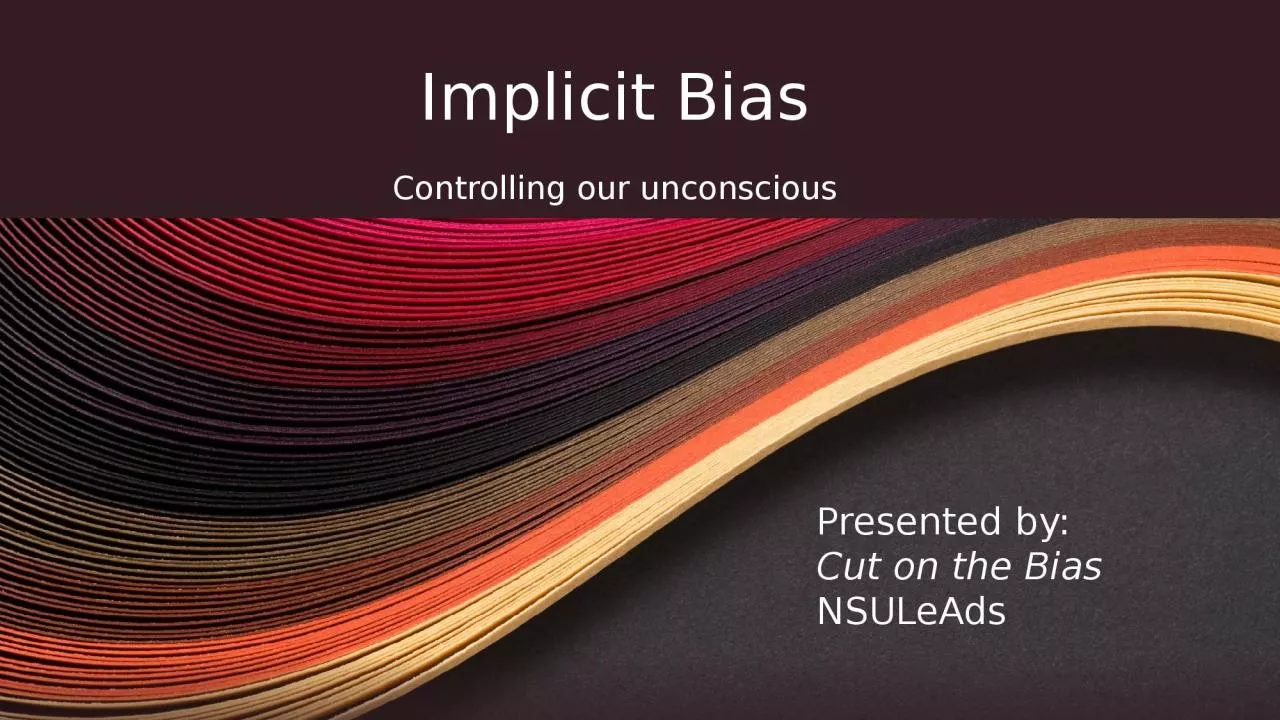

Presented by Cut on the Bias NSULeAds Introduction Student Perspectives What is Implicit Bias Attitudes or stereotypes that affect our understanding actions and desires in an unconscious manner Implicit bias ID: 1030664
Download Presentation The PPT/PDF document "Implicit Bias Controlling our unconsciou..." is the property of its rightful owner. Permission is granted to download and print the materials on this web site for personal, non-commercial use only, and to display it on your personal computer provided you do not modify the materials and that you retain all copyright notices contained in the materials. By downloading content from our website, you accept the terms of this agreement.
1. Implicit BiasControlling our unconsciousPresented by:Cut on the BiasNSULeAds
2. Introduction
3. Student Perspectives
4. What is Implicit Bias?Attitudes or stereotypes that affect our understanding, actions, and desires in an unconscious manner. Implicit bias......is activated involuntarily. ...cannot control for social/political correctness. ...is not accessible through introspection. ...predicts behavior in the real world.
5. Key CharacteristicsBiases are pervasive: everyone has them.Biases do not necessarily align with our declared beliefs or reflect stances we would explicitly endorse. We generally tend to hold biases that favor our own in-group. Biases are malleable.Implicit and explicit biases are related but distinct mental constructs.
6. How to Test Implicit Bias: Implicit Association Test (IAT) at https://implicit.harvard.edu/implicit/takeatest.htmlCase StudyWhite male Professor at NSU who took gender, race, and disability preference testsResults: Strong automatic preference for European Americans over African AmericansModerate automatic preference for Male with Career and Female with FamilyModerate automatic preference for abled over disabledMore details:covers Bias, Institutional Racism, and Disability Studies as part of curriculumWrote dissertation on Disability StudiesMembership in National Disability Societies and Advocacy GroupsChristian in a church that prides itself on acceptance of LGBTQ+ members with leadership that is racially diverse and female-inclusiveLast Test:Strong automatic preference for Bill Clinton over Donald Trump
7. Can you get rid of negative biases?Mindfulness techniquesstate of being—often practiced through meditation—that involves an increased awareness of our emotions, thoughts, and surroundings, accompanied by a sense of acceptance and non-judgment1. Context for people’s actions (correspondence bias)2. Decrease wariness in social encounters (negativity bias)3. See others as equals (self-positivity bias)
8. How do we make that change?Overall, it may be a challengeThere are approaches:I.M.P.L.I.C.I.T.
9. I – IntrospectionExplore yourself and identify your own types of prejudicesCan be done through the self-tests (previously mentioned) or other forms of self-analysisM – MindfulnessPressure, stress, distraction, negative emotion, etc., are more likely to lead towards biasesBe aware of and practice ways to reduce stress and increase mindfulness
10. P – Perspective-taking Consider the experiences and viewpoint of the other person"Don't be too quick to judge" is an old saying that still worksL – Learn to slow down Before interaction, pause and reflect to reduce reflexive actions; for example, if feeling anger or disgust, wait to calm down first
11. I – IndividuationEvaluate a person based on their own personal characteristicsFocus on these personal attributes of an individual rather than the stereotypes tagged with social groupsC – Check your messagingUse conversation that is welcoming and embracing of multiculturism and differencesThe "color-blind" or "we don't see color" approach has been shown in research to increase bias
12. I – Institutionalize equityEstablish and support a culture of diversity and inclusionSeek out these opportunities to interact and work with individuals from stigmatized groups, in both professional and personal contextsT – Take two Resisting these biases is a lifelong process"Take two" and at times restart these processes to look for new ways to improve
13.
14. ConclusionEveryone has implicit biases.They are unconscious (beyond our own awareness) thus may surface in times of heightened emotion and stress. They can contradict our spoken beliefs and values.Mindfulness practices can give us glimpses of our own unconscious implicit biases allowing us to learn and improve ourselves and our society.
15. Implicit Bias is difficult to overcome, but not impossible. Remember to be IMPLICIT in your approach:-Introspection-Mindfulness-Perspective-taking- Learn to slow down-Individuation-Check your Messaging-Institutionalize equity-Take twoConclusion
16. Take – Away ExercisesExamine your inner circle:Create an excel sheet/grid.2. In the first column, write 5 people you absolutely trust.3. In subsequent columns write their gender, ethnicity, religion, political view, education level, etc. 4. If your inner-circle of trusted friends does not have diversity in certain areas, challenge yourself to expand your circle. Take the bias tests for yourself: Go to nsu.la/Bias to get started.
17. Additional Resources
18. Q and A
19. SourcesMason, Betsy. “Curbing Implicit Bias: What Works and What Doesn’t” https://www.discovermagazine.com/mind/curbing-implicit-bias-what-works-and-what-doesntAccessed November 10, 2020.•Suttie, Jill. “Three Ways Mindfulness can make you less biased.” https://greatergood.berkeley.edu/article/item/three_ways_mindfulness_can_make_you_less_biased. Accessed December 8, 2020.Turner, Rhiannon N. “Imagining intergroup contact reduces implicit prejudice” The British Journal of Social Psychology Vol. 49, #1 (March 2010), 129-142. https://doi.org/10.1348/014466609X419901“Understanding Implicit Bias” http://kirwaninstitute.osu.edu/research/understanding-implicit-bias/Accessed 10/26/2020.